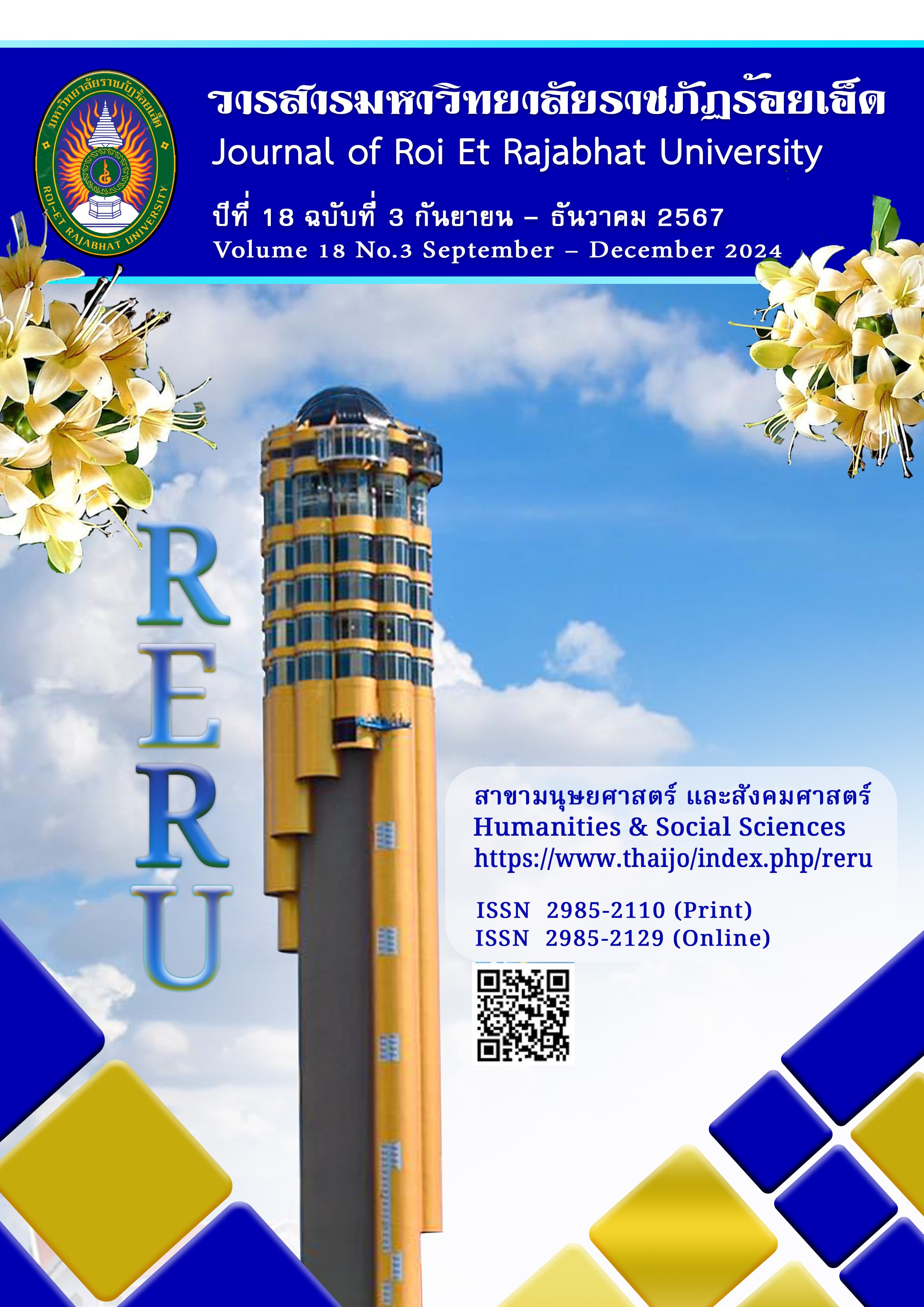A Meta Analysis of Research on Factors Affecting the Effect size of Muay Thai Training Programs
Keywords:
Meta-analysis, Factors affecting the effect size Muay Thai training program, Systematic ReviewAbstract
This research aims to: 1) study the characteristics of research related to factors affecting the effect size of Muay Thai training programs, 2) investigate the effect size of research concerning factors influencing Muay Thai training programs, and 3) compare the characteristics of research related to factors affecting the effect size of Muay Thai training programs. The data sources for this research are 21 studies on Muay Thai training programs conducted between 2010 and 2023. Data were collected using a systematic review, with quality assessment of quasi-experimental research following the guidelines of the Joanna Briggs Institute. Additionally, The research characteristics were evaluated by a panel of five experts using the Content Validity Index (CVI), resulting in an overall score of 4.52, reflecting a satisfactory level. Descriptive statistical methods and content analysis were employed to evaluate the research features. The effect sizes of the research were calculated through meta-analysis using the Hedges' method (1981: 107-128). The findings reveal that most research on factors affecting Muay Thai training programs were master's theses (66%), followed by doctoral dissertations (44%). In terms of academic fields, sports science accounted for the highest percentage (57%), followed by physical education (24%) and other fields (14%).
A comparison of effect size values for six variables influencing the dependent variable of the research on factors affecting Muay Thai training, using One-way ANOVA, showed that four variables had statistically significant differences at the .05 level. These variables are the type of training activity, the number of rounds per training session, rest duration, and the sample size. The effect sizes from these analyzed variables provide knowledge and information that can be applied and integrated with sports training principles to advance the development of Muay Thai training programs.
References
กรมพลศึกษา กระทรวงการท่องเที่ยวและกีฬา. (2559). ประวัติศาสตร์มวยไทย. กรุงเทพฯ: บีทีเอสเพรส.
กิจจา ถนอมสิงหะ และจินตนา สรายุทธพิทักษ์. (2560). การพัฒนารูปแบบกิจกรรมการออกกำลังกายโดยใช้ศิลปะมวยไทย เพื่อส่งเสริมคุณภาพชีวิตของนักเรียนระดับมัธยมปลาย. วารสารครุศาสตร์, 45(1), 1-17.
เจริญ กระบวนรัตน์. (2557). การวางแผนโปรแกรมการฝึกซ้อมในกีฬา. กรุงเทพฯ: การกีฬาแห่งประเทศไทย.
ประยูรศรี บุตรแสนคม. (2558). การพัฒนารูปแบบการส่งเสริมทักษะการคิดขั้นสูงของนักเรียน: การประยุกต์ใช้ ผลการวิเคราะห์โมเดลสมการโครงสร้างอภิมาน. ดุษฎีนิพนธ์ ปรัชญาดุษฎีบัณฑิต สาขาวิชาวิจัยและประเมินผลการศึกษา. มหาสารคาม: มหาวิทยาลัยมหาสารคาม.
รังสฤษฏิ์ บุญชลอ. (2560). มวยไทย รวมกฎ กติกา และพื้นฐานการเล่น. ปทุมธานี: สกายบุ๊ค.
ราชัน เฉลียวศิลป์. (2558). มวยไทย. สุพรรณบุรี: สถาบันพลศึกษาวิทยาเขตสุพรรณบุรี.
วันใหม่ ประพันธ์บัณฑิต. (2562). ผลของโปรแกรมการฝึกกล้ามเนื้อเฉพาะเจาะจงที่มีต่อความสามารถในการเตะตัดของมวยไทย การวิเคราะห์ทางสรีรวิทยาและชีวกลศาสตร์ ดุษฎีนิพนธ์ ปรัชญาดุษฎีบัณฑิต สาขาวิชาวิทยาศาสตร์การออกกำลังกายและการกีฬา. ชลบุรี: มหาวิทยาลัยบูรพา.
สุวิมล ว่องวาณิช และนงลักษณ์ วิรัชชัย. (2546). แนวทางการให้คำปรึกษาวิทยานิพนธ์. กรุงเทพฯ: ศูนย์ตำราและเอกสารทางวิชาการ จุฬาลงกรณ์มหาวิทยาลัย.
อนันต์ อัตชู. (2538). หลักการกีฬา. กรุงเทพฯ: โรงพิมพ์ไทยวัฒนาพานิช.
อัจฉรา คำมะทิตย์ และมัลลิกา มากรัตน์. (2559). การทบทวนวรรณกรรมอย่างเป็นระบบ: วิธีการปฏิบัติทีละขั้นตอน. วารสารเครือข่ายวิทยาลัยพยาบาลและการสาธารณสุขภาคใต้, 3(3), 246-248.
อริย์ธัช หนูแก้ว. (2561). ผลของโปรแกรมการฝึกมวยไทยแบบวงจรที่มีต่อความสามารถทางอากาศนิยมของนักมวยไทยอาชีพ วิทยานิพนธ์ วิทยาศาสตรมหาบัณฑิต สาขาวิชาวิทยาศาสตร์การกีฬา. กรุงเทพฯ: จุฬาลงกรณ์มหาวิทยาลัย.
ไอยย์ศรัย พีรภาพรกุล. (2555). ผลของการเรียนการสอนฟุตบอลโดยใช้โปรแกรมการฝึกแรงต้านที่มีต่อพลังกล้ามเนื้อขา ของนักกีฬาฟุตบอลระดับอุดมศึกษา วิทยานิพนธ์ ครุศาสตรมหาบัณฑิต สาขาวิชาสุขศึกษาและพลศึกษา. กรุงเทพฯ: จุฬาลงกรณ์มหาวิทยาลัย.
Becker, A. L. (2000). Effect Size. Retrieved, from https://web.uccs.edu/lbecker/Psy590/es.htm
Goto, K. Ishii, N. and Takamatsu, K. (2004). Growth hormone response to training regimens with combined high and low-intensity resistance exercises. European Journal of Applied Physiology, 92(2), 231-242.
Hair, J. F. Black, W. C. Babin, B. J. Anderson, R. E. and Tatham, R. L. (2006). Multivariate Data Analysis (6thed.). Pearson Prentice Hall.
Hedges, L. V. (1981). Distribution theory for Glass’s estimator of effect size and related estimators, Journal of educational statistics, 6(2), 107-128.
Jones, M. J. Brown, A. and Davis, R. (2010). Lactic Acid Clearance during Different Recovery Durations in Combat Sports. International Journal of Physiology, 15(2), 112-118.
Johnson, R. (2015). The Impact of Circuit Training on Muscular Strength in Combat Sports. Sports Medicine Journal, 20(3), 45-60.
Miller, R. Stewart, D. and Greene, T. (2008). Experimental Psychology: Methods and Applications. New York: McGraw-Hill.
National Association for Sport and Physical Education. (2011). Physical Education for Lifelong Fitness: The Physical Best Guide (3rd ed.). Illinois: Human Kinetics.
Smith, J. and Jones, A. (2015). Effect of High-Intensity Training on Muay Thai Athlete’s Performance. Journal of Sports Science, 23(2), 156-162.
Smith, A. Johnson, M. and Kauffman, D. (2010). The effect of set and repetition variations on muscle strength and hypertrophy in resistance training. Journal of Strength and Conditioning Research, 24(3), 715-722.
Smith, A. and Jones, B. (2010). Physical Training in the Elderly: Effects and Benefits. New York City: Springer.
Smith, A. and Jones, B. (2017). The effects of alternating heavy and light training on boxers. Journal of Sports Science and Conditioning, 12(3), 45-59.
Smith, J., Johnson, P., Lee, K. and Davis, M. (2005). Recovery Duration and its Effect on Muay Thai Performance. Journal of Sports Science, 23(3), 45-50.
The Joanna Briggs Institute. (2011). Joanna Briggs Institute reviewers’ manual: 2011 edition. Retrieved July 6, 2022, from http://www.Joanna Briggs.edu.au/Documents/sumari/ Reviewers%20Manual-2011.pdf
Turner, A. N. (2009). Strength and conditioning for Muay Thai athletes. Strength and Conditioning Journal, 31(6), 78-92.
Wong, P. (2017). Accelerated Training Techniques in Enhancing Endurance and Speed of Muay Thai Athletes. Journal of Physical Education and Sport, 17(3), 102-110.
Downloads
Published
How to Cite
Issue
Section
License
Copyright (c) 2024 Roi Et Rajabhat University

This work is licensed under a Creative Commons Attribution-NonCommercial-NoDerivatives 4.0 International License.
บทความที่ได้รับการตีพิมพ์เป็นลิขสิทธิ์ของวารสารมหาวิทยาลัยราชภัฎร้อยเอ็ด
ข้อความที่ปรากฏในบทความแต่ละเรื่องในวารสารวิชาการเล่มนี้เป็นความคิดเห็นส่วนตัวของผู้เขียนแต่ละท่านไม่เกี่ยวข้องกับมหาวิทยาลัยราชภัฎร้อยเอ็ด และคณาจารย์ท่านอื่นๆในมหาวิทยาลัยฯ แต่อย่างใด ความรับผิดชอบองค์ประกอบทั้งหมดของบทความแต่ละเรื่องเป็นของผู้เขียนแต่ละท่าน หากมีความผิดพลาดใดๆ ผู้เขียนแต่ละท่านจะรับผิดชอบบทความของตนเองแต่ผู้เดียว





